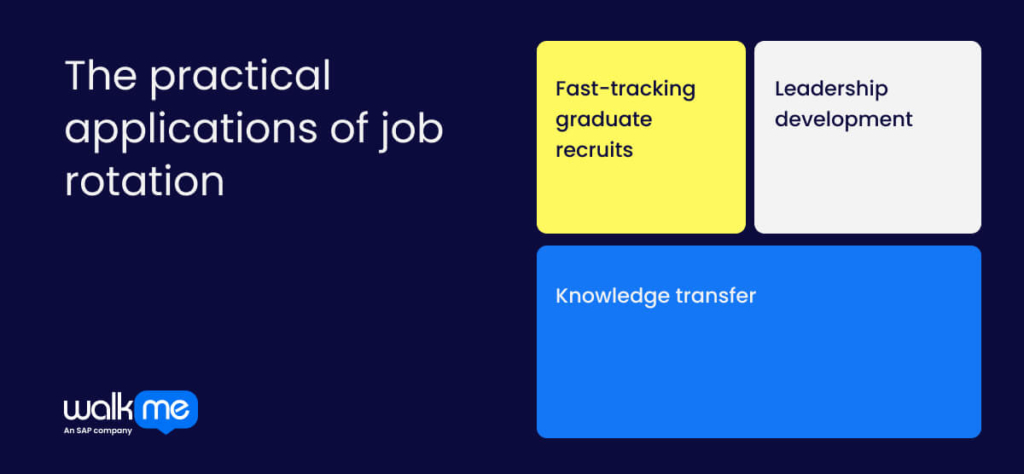Job rotation is a key feature of top business training programs and a valuable method within various types of employee training. It challenges employees to grow, adapt, and thrive in complex work environments.
While not the simplest method, the right approach, candidates, and oversight can make it a powerful tool for development.
A German banking and financial services study found that job rotation led to higher subsequent performance among employees. High performers, in particular, saw the greatest benefits, reinforcing job rotation as a valuable strategy for employee development.
This article explores job rotation, the methods used, real-world examples, and the benefits and challenges of incorporating it into employee development programs.
What is job rotation?
Job rotation is a training method where employees switch roles within a company to learn new skills. It can last from a few days of shadowing to months in a different department. This helps companies develop talent, plan for change leadership, and stay adaptable.
Job rotation is often used in industries like manufacturing and healthcare, but any company with clear career paths and strong management can benefit from it. It works well in businesses that need team dynamics across departments. Employees at all levels—from new hires to executives—can gain valuable experience.
For workers, job rotation improves skills, introduces fresh challenges, and makes work more interesting. While it takes planning, it helps employees understand different parts of the business, making them more effective.
However, job rotation doesn’t work for every role. Jobs with urgent tasks, strict safety rules, or limited career growth may not fit well. In those cases, other training methods might be better.
What are the different types of job rotation?

This section explores three types of job rotation: job shadowing, traditional job rotation programs, and cross-training.
Each requires different levels of commitment, organization, and employee involvement. They can also be adapted to fit various business needs.
One key challenge in job rotation is workforce planning. Whether implementing a small or large-scale program, businesses must ensure enough employees can cover all tasks. This can be complex, but workforce management tools like monday.com can help streamline planning.
Now, let’s take a closer look at the three main types of job rotation:
- Job shadowing
- Job rotation programs
- Cross-training
Job shadowing
Job shadowing is a training and mentoring approach in which an individual, typically a new or less experienced employee, observes and learns from a more experienced colleague by spending time with them during their daily work activities.
Job shadowing provides the observer firsthand insights into the responsibilities, tasks, and expectations of a particular job or role.
How to implement job shadowing
In some cases, you can implement job shadowing as an informal method of continuous employee training.
It’s quite easy to make this arrangement within one small business unit. But if you plan to make shadowing a bigger part of your human resources management strategy, you should go through the following steps:
- Establish clear guidelines for your job shadowing program. Define who the program applies to and outline the objectives of the experience. This will help determine who can participate as both hosts and mentors.
- Carefully match participants with hosts based on their career goals, interests, and areas for growth. Select hosts who are willing and capable of providing valuable, insightful experiences.
- Before the job shadowing begins, hold an orientation session for both participants and hosts.
- Address any questions or concerns to ensure everyone is aligned and prepared.
Tips for using job shadowing
When you’re trying to implement or improve job rotation in your organization, take the following tips on board:
- Job shadowing: Although it can feel short-term and ad hoc, it should align with your company’s strategic goals.
- Troubleshooting: Be ready to address issues if candidates or mentors struggle with the agreement. HR may need to step in for tough conversations.
- Scheduling challenges: Scheduling is often the hardest part. Address logistical issues, like conflicts or resource limitations, and streamline the process with relevant departments.
Who’s it for?
Job shadowing can be useful for staff at all levels of an organization. However, it’s commonly connected with people who want to become leaders.
Job rotation programs
A job rotation program is a structured initiative designed by organizations to systematically move employees through different roles, departments, or functions.
The program aims to provide participants with a well-rounded experience, enhance their skills, and prepare them for various responsibilities within the organization.
How to implement job rotation programs
Organizing a job rotation program will always be a big deal. From the point of view of company-wide human resources, consider the following steps:
- Identify the area where job rotation can most impact your company. This could be a specific business unit, employee role, or location within the company.
- Consult with key stakeholders to gain buy-in from relevant leaders; participants may not benefit from the experience without their support. You may also need to provide additional training for managers overseeing rotating staff.
- Recruit participants for the program, either by invitation or through internal advertisements.
- Monitor and assess the program’s effectiveness. A job rotation program should have clear objectives and KPIs and a solid feedback loop to track whether it’s achieving the desired outcomes.
Tips for using job rotation programs
In the process of organizing your job rotation scheme, think about these additional tips for success:
- Job rotation challenges: Organizing a job rotation program is complex. Acknowledge the potential challenges of moving employees through different roles and plan accordingly.
- Soft skills training: Include soft skills training to help participants navigate challenging situations. Focus on communication, teamwork, and adaptability for success in rotations.
- HR support: Assign dedicated HR staff to manage the program. A clear point of contact ensures efficient communication, problem-solving, and smooth implementation.
Who’s it for?
In white-collar workplaces, job rotation is most useful for high-potential candidates. Whether that’s for fast-track recruits, executive leadership, or building a pool for succession planning, job rotation helps prospective candidates excel.
Cross training
In cross-training, training employees learn tasks or responsibilities outside of their primary job roles. Unlike traditional job rotation, where employees move between distinct roles or departments, cross-training focuses on developing a broader skill set within the same team or functional area.
How to implement cross-training
Cross-training can be implemented in several different ways. Depending on your needs, you might want ad hoc or self-directed activities, structured cross-training modules, or a wide-ranging cross-training program.
- Ad-hoc or self-directed activities allow team members to take the lead in learning about different roles or functions within the organization based on their interests or immediate needs. This approach offers flexibility, enabling individuals to customize their learning experiences according to their development goals.
- Structured cross-training modules involve creating a curriculum with defined learning paths using classroom sessions, workshops, and hands-on experiences. This structured approach ensures a well-organized and systematic progression, helping participants build a broad skill set across various departments or functions.
- A formalized cross-training program is a planned initiative by the organization to expose employees to different roles. It involves management identifying key skills and knowledge areas and matching employees with appropriate training opportunities.
Tips for using cross-training
In the process of implementing your cross-training program, consider these key tips for success:
- Self-directed activities: Allow team members to lead their learning based on interests or immediate needs. This offers flexibility and aligns with personal development goals.
- Structured modules: Create a clear curriculum with defined learning paths. Mix methods like workshops and hands-on experiences for systematic skill-building.
- Formalized program: Implement a planned initiative where management identifies key skills and matches employees with appropriate cross-training opportunities.
Who’s it for?
Cross-training is valuable for any role that requires a diverse and adaptable skill set. It’s particularly beneficial for leadership teams, as it helps build a broad understanding of the organization. Additionally, cross-training can strengthen technical teams by enhancing their ability to collaborate across departments and adapt to changing business needs.
The practical applications of job rotation

Job rotation offers practical benefits by helping employees develop new skills, improve flexibility, and increase engagement.
This section explores how job rotation can be applied effectively in various business settings.
Fast-tracking graduate recruits
Job rotation is helpful for new graduate recruits stepping into managerial roles. When new employees join, they get a broad view of the company, allowing them to explore different roles. This helps them understand how the company works without locking them into one career path too early.
Through job rotation, graduates can identify their strengths, interests, and areas of potential excellence within the company.
This experience also helps develop leadership skills by giving recruits a well-rounded perspective and the ability to adapt, which is important for future managerial positions.
Leadership development
As staff advance in an organization, understanding every aspect of the business is essential for effective leadership skill development. Great leaders cannot remain confined to their specific area; they must develop a holistic view of the entire organization.
Job rotation plays a key role in achieving this. It exposes emerging leaders to various roles and functions within the company, providing firsthand experience across different parts of the business.
This hands-on learning broadens their skill set, nurtures strategic thinking, and promotes adaptability. It also helps them appreciate the interconnectedness of various functions within the organization.
Knowledge transfer
Job rotation supports the exchange of both explicit and tacit knowledge. This collaborative training ensures that essential knowledge isn’t confined to specific roles, reducing reliance on individual experts.
It speeds up the onboarding process, strengthens team cohesion, and enables cross-functional collaboration.
Ultimately, job rotation fosters a culture of continuous learning, making the team more versatile, cohesive, and prepared for the organization’s dynamic challenges.
What are the benefits of job rotation?
We’ve discussed several key aspects of job rotation, including its role in fostering collaboration, offering specialized training, and breaking down knowledge silos.
In this section, we will explore the benefits of job rotation:
Encourages buy-in for the organizational vision
Forms of job rotation offer a unique way of achieving a multifaceted perspective of the company.
As employees navigate various responsibilities, they develop a comprehensive view of the organization’s goals, values, and interconnected operations. This firsthand experience cultivates a stronger commitment to the organizational vision and instills a sense of ownership and alignment as individuals recognize their integral role in achieving the shared objectives.
Support career development
Job rotation gives employees a great chance to grow in their careers. It helps them learn how different parts of the company work and build skills that improve their job performance. Employees also get the chance to meet and work with people from other departments. Job rotation helps develop both general and job-specific abilities, making employees more effective at work. Career growth through job rotation leads to higher job satisfaction, which is important for keeping talented employees.
Job rotation makes it easier to replace staff
Job rotation helps ensure smooth staffing transitions at all levels of the organization. When many employees go through a job rotation program, the company has a group of people who are ready to step into specific roles. When specialized staff leave, someone who has already been trained through job rotation can step in quickly. Since turnover is inevitable, job rotation helps reduce disruptions by ensuring key roles are always filled by people ready for the responsibilities.
What are the challenges associated with job rotation?
Use job rotation strategically to avoid drawbacks, focus on employees eager to learn more about the organization, and ensure the program is well-targeted.
In this section, we will explore the benefits of job rotation:
Time commitment
Introducing job rotation requires significant time and effort, especially during the initial setup. Managers and HR must invest substantial resources to ensure a well-structured program. Balancing the planning effort with the expected outcomes is essential, as careful preparation is key to the program’s long-term success. Despite the challenges, thorough planning is vital for unlocking the full potential of a job rotation initiative.
Short-term Inefficiencies
In the long term, job rotation is an effective training method, offering participants valuable experiences for their careers. However, in the short term, it can cause inefficiencies. As participants adjust to new roles, they may not manage situations as effectively, leading to slower processes. While these short-term challenges are inevitable, they ultimately contribute to smoother transitions and greater long-term success in the job rotation program.
Job rotation can produce stress
Job rotation is a valuable talent development strategy unsuitable for every employee. Science Direct found that it can increase stress and cause anxiety, anger, and even sabotage behaviors. Job rotation should be applied carefully, considering potential stressors, and tailored to situations that benefit employees and the organization. Recognizing job rotation’s stressors helps organizations apply them wisely and ensure positive outcomes.
Could job rotation be right for you?
Today’s workers must be adaptable, skilled, and ready to face different challenges.
It is rare to find a managerial candidate with relevant experience. Job rotation helps bridge that gap by giving employees hands-on exposure to different roles.
While structured programs like graduate schemes take time to set up, informal cross-training can still introduce knowledge-sharing and skill development. Even small steps toward job rotation can build a workforce that is more capable, versatile, and prepared for leadership.
Investing in these opportunities helps employees grow while strengthening the organization’s ability to handle new demands.
FAQs
Job rotation helps employees gain experience in different roles, making them more skilled and adaptable. It keeps work interesting, improves problem-solving, and allows companies to find future leaders. Employees also build stronger connections across teams, making it easier to work together and share knowledge.
Job rotation is temporary and meant for learning, allowing employees to try different roles. A transfer is permanent, moving someone to a new position for good. Rotation helps develop skills, while a transfer fills a company’s needs or supports an employee’s career growth in a new role.
The length depends on the company and role. Some rotations last a few weeks, while others take months. Shorter rotations give quick exposure, while longer ones allow deeper learning. A good rotation lasts long enough for employees to develop useful skills without slowing down the company’s work.

